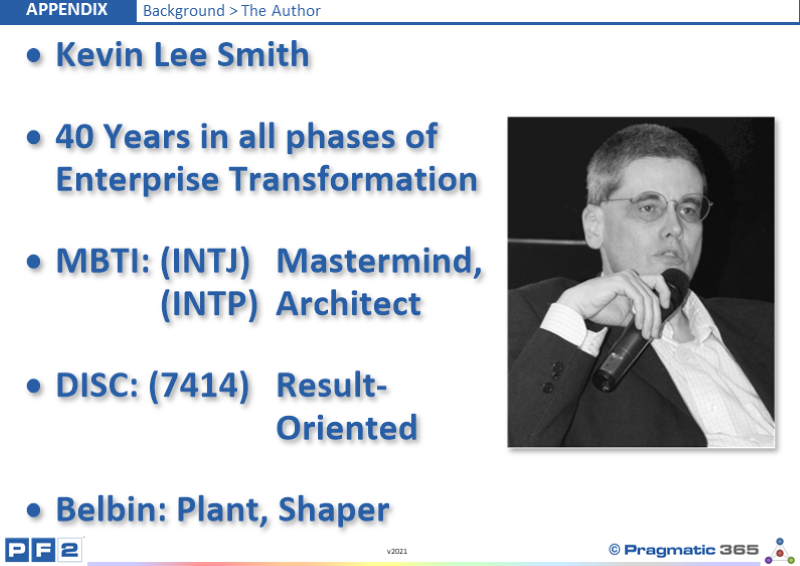https://pragmatic365.org/display-show.asp?Showname=BOOKF-GOVERNANCE&ComponentNo=000701
What are the MBTI, DISC and Belbin profiles of the people in your Enterprise?
Do they all suit their roles?
Have you ever found someone to be a “difficult person” or a “loose cannon”?
If so, did their MBTI/DISC/Belbin profile taken into account?
https://pragmatic365.org/display-show.asp?Showname=BOOKF-GOVERNANCE&ComponentNo=000701
FREE EA Training at www.PEAF.com/Training
FREE EA Books at www.PEAF.com/Books
#PEAF #PragmaticEA #EntArch #enterprisearchitecture #BizArch #Change #Innovation #BusinessModel #CEO #Strategy #TOGAF #ITgovernance #agileculture #agile #agileleadership #agilemethodology #itstrategy #ceos
Use people for the type of person they are, not the type of person you want them to be. If we were all the same, nothing would ever get done.
https://pragmatic365.org/display-show.asp?Showname=BOOKF-GOVERNANCE&ComponentNo=000701

Who Created The Pragmatic Family
of Frameworks (PF2)?
A simple man.
My career began at the age of 16 in 1978 as an Electrical
and Electronic Apprentice with Marconi Radar Systems (Blackbird Road,
Leicester, UK) At that time I was really into electronics and had been playing
with little circuits for a few years. It was really exciting. I spent my time
between college and “The Factory” where I got the chance to work in many
different departments. It was really exciting. Around 1980 I ended up in a
Department (New Parks, Leicester UK) called TEPIGEN (TElevision
PIcture GENerator)
who had built the visual system for a ship simulator. Six million Pounds of
custom built hardware (that had less processing power than the CPU in the phone
that’s in your pocket) consisting mainly of four racks of “Picture Processors”
(Motorola 68000s) driven by a PDP11. It was really exciting. The output was on
three channels each delivering 40 degrees field of view which drove three large
Barco projectors. Interestingly at one point there were black speckles that
kept appearing on the displays, moving about in random patterns and appearing
and disappearing in the same apparently random fashion. After months of
software and hardware investigation the problem was identified. It was a test
Radar across the apron from where our Portacabins where located that was
spraying us periodically with microwaves! It was really exciting. ...to read more, please Login or Register |
Keypoint |
Adopt this component by... |
Use people for the type of person they are, not the type of person you want them to be. If we were all the same, nothing would ever get done.
|
|
Questions to ponder... |
What are the MBTI, DISC and Belbin profiles of the people in your Enterprise? |
Do they all suit their roles? |
Have you ever found someone to be a “difficult person” or a “loose cannon”? |
If so, did their MBTI/DISC/Belbin profile taken into account? |